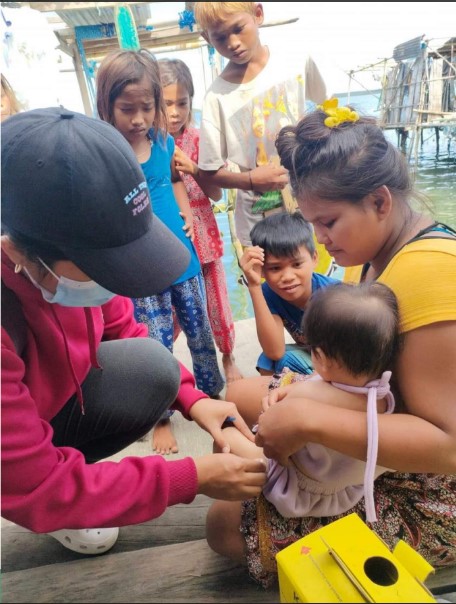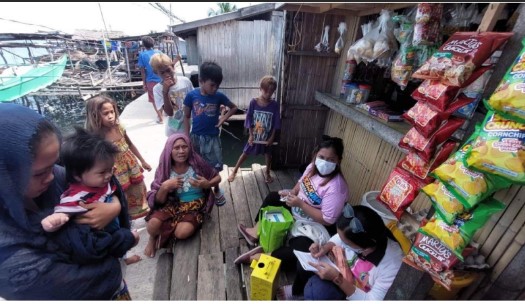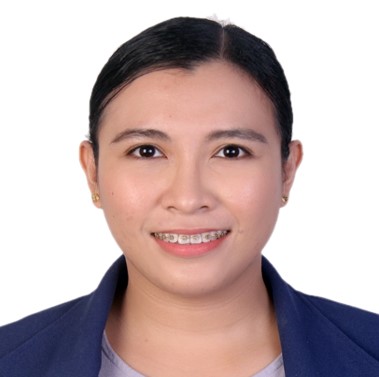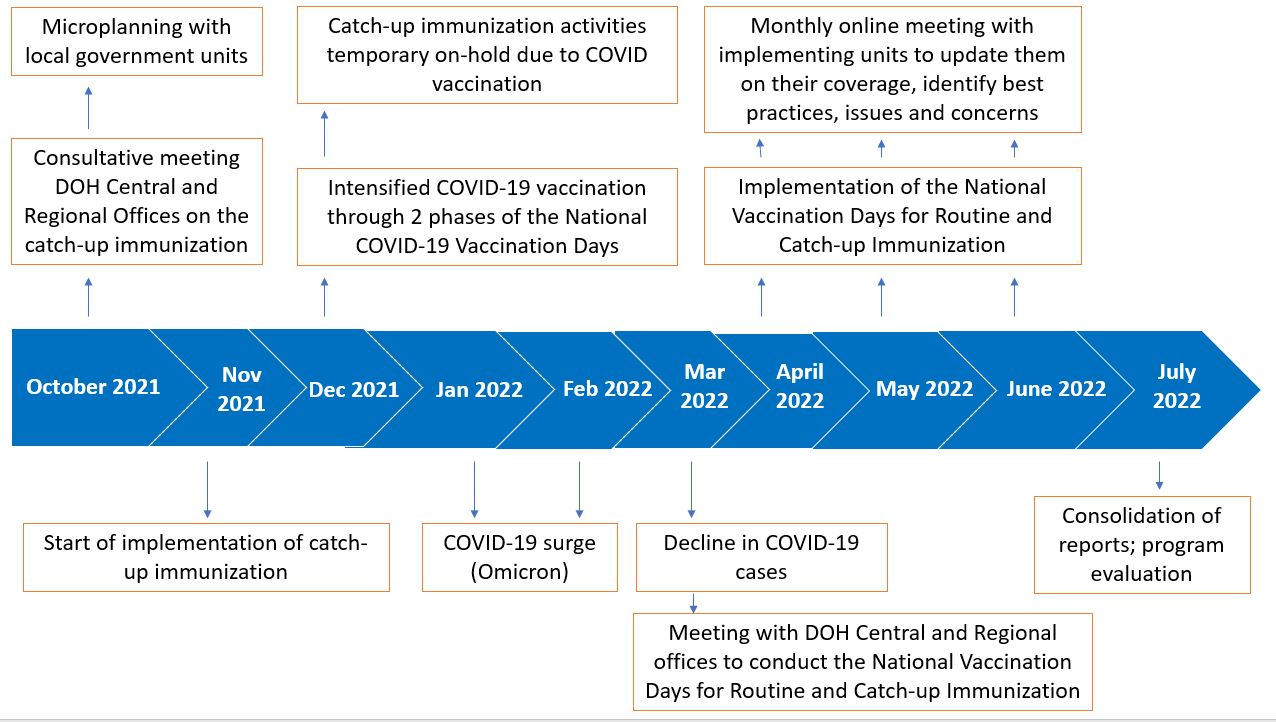Catch-up Routine Immunization to Restore Childhood Immunization Coverage Following COVID-Induced Declines in Zamboanga Peninsula, Philippines
In May 2022, Sabin’s Boost Community and the World Health Organization (WHO) launched the first cohort of the "COVID-19 Recovery for Routine Immunization Programs Fellowship". The aim of this program was to strengthen the capacity of national and sub-national immunization professionals to plan and implement immunization programming during the COVID-19 recovery period, with the ultimate goal of reversing the declining rates of immunization coverage. After an intensive live engagement series, Fellows were tasked with drafting their own strategic proposal for implementation or case study for publication. This series of Bright Spots that shares Fellows' key learnings and takeaways from the program.
Introduction
Even before the COVID-19 pandemic, immunization rates were low and declining in the Philippines, where the national-level Fully-Immunized Child (FIC) coverage decreased from 70% in 2015 to only 61.5% in 2020. The 2017 Dengvaxia controversy, in which an alleged increased risk for dengue was reported among children who received school-based immunization, contributed to this decline, resulting in measles and polio outbreaks in 2018 and 2019.¹ Starting with the first case of COVID-19 in the Philippines in March 2020, the WHO and UNICEF have sounded an alarm on the possible decline of routine immunization, predicting two million children in the Philippines may miss out on vaccination.² With the threat of disease resurgence, the Department of Health (DOH) instituted the Measles-Rubella (MR) and Oral Polio Vaccine (OPV) Supplemental Immunization Activity (SIA) from October to November 2020 to interrupt disease transmission. ¹
Zamboanga Peninsula, with a total population of 3,834,801, is in the western part of Mindanao Island, Philippines. Consisting of three provinces, more than 18% of its 1,904 barangays (the smallest administrative division in the Philippines) belong to geographically isolated and disadvantaged areas (GIDA). With intensified campaigns before the start of the pandemic, the FIC rate in Zamboanga Peninsula increased to 63% in 2020; however further declines in FIC coverage were experienced after the COVID-19 pandemic began. Though the Zamboanga Peninsula achieved population immunity of 95.8% among children ages 9-59 months for OPV/IPV and MCV through the MR and OPV Supplemental Immunization Activity, FIC coverage rates continued to decrease to 52% in the first quarter of 2021.
Given the need to maintain immunity to prevent outbreaks, the DOH issued streamlined guidelines for conducting routine catch-up immunization activities, which began in October 2021. However, COVID-19 vaccination and routine immunization efforts continued to share and compete for the same resources (e.g., human resources, logistics, providers, commodities, and local government unit commitment), leading to lower routine immunization coverage and an increase to only 59% FIC coverage in Zamboanga Peninsula by the end of 2021.
Intervention

Following the successful stakeholder collaboration conducted for coordination and planning of National COVID-19 Vaccination Days, the National Inter-Agency Task Force for Emerging Diseases (NIATF) created multi-agency policies to address supply needs and gaps in demand generation, endorsing the redirection of human resources to conduct routine and catch-up activities. The DOH also created guidelines for national vaccination days for catch-up activities for under-immunized vulnerable children, called “Chikiting Bakunation Days: National Vaccination Days for Catch-up and Routine immunization”. The target for the catch-up immunization campaign was to vaccinate at least 80% of infants ages 0-23 months who missed any of their routine immunizations.
In October 2021, the National Immunization Program (NIP) Manager met with representative NIP coordinators at the sub-national/regional DOH offices to create and disseminate guidelines for routine catch-up for immunization. These guidelines were then cascaded to all NIP coordinators, including those from the Zamboanga Peninsula.
Four micro-planning workshops were conducted to plan activities in the Zamboanga Peninsula: one in Zamboanga City and Isabela City, one in Zamboanga Sibugay, one in Zamboanga del Norte, and one in Zamboanga del Sur. Conducted virtually due to COVID-19 movement restrictions, these sessions enabled collaboration among the Health Officers, NIP coordinators, and Health Education and Promotion officers of the different provinces, cities and municipalities of Zamboanga Peninsula. Inter-agency stakeholders also attended, such as health and nutrition sector representatives from the Department of Education, Philippine National Police, and the Department of Social Welfare and Development; governance sector representatives of the Department of Interior and Local Government; and local chief executives.
Participants in these micro-planning workshops planned the following activities at the provincial, city, and municipal levels:
Assessment of immunization reports and coverage to identify barangays and puroks, a zone within the barangay, with a high number of unimmunized children.
Identification of children under 23 months who missed their primary immunization series through a review of master listings, target client lists, and immunization cards.
Hosting of routine catch-up immunization activities the final week of each month, utilizing strategies such as door-to-door vaccination, modified fixed posts (e.g., school/barangay gymnasiums, temporary outreach sites in puroks), and fixed sites (e.g., barangay health station, rural health units, district health centers).
Recording of all activities, updating of target children lists, and sharing of routine catch-up accomplishments.
Sharing of vaccine supply chain and management procedures and the surveillance and reporting of adverse events following immunization (AEFI) with the DOH.
The DOH Zamboanga Peninsula Center for Health Development also led coordination with the Regional Inter-Agency Task Force on COVID-19 (RIATF) to receive endorsement of the implementation of these catch-up immunization activities. The endorsement by this collaborative partnership and policy-making body of regional government agencies and stakeholders in the Zamboanga Peninsula enabled local chief executives to ensure responsibility for the implementation of activities in their area.
The mobilization of vaccination teams, vaccine freight and cold chain, supplies (e.g., AD syringes, cotton balls), and the coverage for all antigens at the regional level (all cities, and municipalities combined) were all addressed in planning processes to ensure success of the campaign. Stakeholder collaboration continued to be critical to implement the routine immunization catch-up activities to address staffing challenges. Nurses and midwives from the municipal and city health offices supported the immunization activities held the final week of each month, as did staff from the Philippine Red Cross. The Barangay council conducted health promotion activities, spearheaded by the barangay captain, barangay councilors, barangay health workers and barangay health emergency response teams.
Alongside these routine and catch-up immunization activities, the DOH addressed the impact of the Dengvaxia controversy, which had perpetuated high levels of vaccine hesitancy. The DOH created promotional materials with educational information on the benefits of routine immunization and held numerous town hall meetings across all multimedia platforms to discuss the importance of childhood immunization. Interviews were conducted with field experts, local chief executives, and tribal leaders who shared their trust in the safety of immunization through the media. The DOH also ensured transparency of government processes during immunization services.
Results
Planned catch-up routine immunization activities began in November 2021 but only lasted one month due to a COVID-19 outbreak and the need for intensified COVID-19 vaccination efforts from December 2021 through February 2022. When COVID-19 cases decreased in March and resources could be reallocated, the DOH-DPCB (Department of Health – Disease Prevention and Control Bureau) championed the National Vaccination Days for Routine and Catch-up Immunization from April to June 2022, allotting the last Thursday and Friday of each month for intensified catch-up immunization activities; these National Vaccination Days for Routine and Catch-up Immunization were then adopted at the regional level.
Leveraging the stakeholder coordination and preparation for the intensified catch-up during the fall of 2021, DOH Zamboanga Peninsula Center for Health Development held conversations with the local chief executives to ascertain their logistical and operational support. The same activities were implemented as previously planned.
Following implementation, a record review was conducted on data from municipal and provincial health offices and then consolidated at the regional level. The following tables present the target number of children with missed doses, the number of doses given during catch-up activities, and immunization coverage among children with missed doses, per antigen for OPV/IPV, MCV, Penta and PCV vaccines.
Overall, almost half (48.22%) of the targets were achieved during the catch-up vaccination activities, however substantial variation was seen by province and city, from 2% to 195%. For example, OPV1 coverage was 2% for Pagadian City but 140% for Zamboanga City. MCV2 was 29% in Pagadian City, but 195% for Isabela City. For variation by vaccine, approximately 50% of the missed children were vaccinated with OPV1, OPV2, and OPV3 but only 31% of the target population received IPV2. For MCV1, 56% of missed children received this dose and 59% received their MCV2 vaccine during the catch-up campaign.
| Table 1. Catch-up immunization coverage among infants ages 0-23 months who missed their routine immunizations by antigen and municipality, Zamboanga Peninsula, April - June 2022 (IPV) | ||||||
|---|---|---|---|---|---|---|
| - | IPV (1st Dose) | - | - | IPV (2nd Dose) | - | |
| - | Target | Total Doses Given | Percent % | Target | Total Doses Given | Percent % |
| Region 9 | 27,633 | 15,646 | 56.62% | 75,867 | 24,076 | 31.73% |
| Dapitan City | 166 | 134 | 81% | 1,755 | 1,108 | 63% |
| Dipolog City | 704 | 559 | 79% | 2,794 | 1,288 | 46% |
| Zamboanga City | 3,623 | 4,615 | 127% | 18,596 | 7,584 | 41% |
| Pagadian City | 1,043 | 236 | 23% | 4,290 | 352 | 8% |
| Isabela City | 640 | 900 | 141% | 2,544 | 1,388 | 55% |
| Zamboanga Del Norte | 5,526 | 3,559 | 64% | 17,145 | 4,590 | 27% |
| Zamboanga Del Sur | 9,351 | 3,545 | 38% | 13,751 | 5,585 | 41% |
| Zamboanga Sibugay | 6,580 | 2,098 | 32% | 14,992 | 2,181 | 15% |
| Table 2: Catch-up immunization coverage among infants ages 0-23 months who missed their routine immunizations by antigen and municipality, Zamboanga Peninsula, April - June 2022 (OPV) | ||||||||||
|---|---|---|---|---|---|---|---|---|---|---|
| - | OPV (1st Dose) | - | - | OPV (2nd Dose) | - | - | OPV (3rd Dose) | - | - | |
| - | Target | Total Doses Given | Percent % | Target | Total Doses Given | Percent % | Target | Total Doses Given | Percent % | |
| Region 9 | 25,893 | 13,698 | 52.9% | 26,724 | 13,728 | 51.37% | 27,414 | 14,824 | 54.07% | |
| Dapitan City | 145 | 117 | 81% | 153 | 126 | 82% | 165 | 135 | 82% | |
| Dipolog City | 686 | 431 | 63% | 691 | 458 | 66% | 732 | 541 | 74% | |
| Zamboanga City | 3,035 | 4,249 | 140% | 3,638 | 4,080 | 112% | 3,730 | 4,202 | 113% | |
| Pagadian City | 1,132 | 23 | 2% | 1,159 | 133 | 11% | 1,083 | 200 | 18% | |
| Isabela City | 675 | 775 | 115% | 634 | 733 | 116% | 607 | 752 | 124% | |
| Zamboanga Del Norte | 4,910 | 3,444 | 70% | 5,012 | 3,287 | 66% | 5,411 | 3,571 | 66% | |
| Zamboanga Del Sur | 9,182 | 2,677 | 29% | 9,192 | 2,956 | 32% | 9,340 | 3,382 | 36% | |
| Zamboanga Sibugay | 6,128 | 1,982 | 32% | 6,245 | 1,955 | 31% | 6,346 | 2,041 | 32% | |
| Table 3: Catch-up immunization coverage among infants ages 0-23 months who missed their routine immunizations by antigen and municipality, Zamboanga Peninsula, April - June 2022 (MCV) | |||||||
|---|---|---|---|---|---|---|---|
| - | MCV (1st Dose) | - | - | MCV (2nd Dose) | - | - | |
| - | Target | Total Doses Given | Percent % | Target | Total Doses Given | Percent % | |
| Region 9 | 28,342 | 15,919 | 56.17% | 27,034 | 15,990 | 59.15% | |
| Dapitan City | 153 | 126 | 82% | 165 | 131 | 79% | |
| Dipolog City | 678 | 566 | 83% | 676 | 678 | 100% | |
| Zamboanga City | 4,233 | 5,234 | 124% | 4,093 | 5,092 | 124% | |
| Pagadian City | 1,344 | 321 | 24% | 1,424 | 411 | 29% | |
| Isabela City | 728 | 875 | 120% | 443 | 864 | 195% | |
| Zamboanga Del Norte | 5,273 | 3,456 | 66% | 4,691 | 3,408 | 73% | |
| Zamboanga Del Sur | 9,660 | 3,378 | 35% | 9,434 | 3,379 | 36% | |
| Zamboanga Sibugay | 6,273 | 1,963 | 31% | 6,108 | 2,027 | 33% | |
| Table 4. Catch-up immunization coverage among infants ages 0-23 months who missed their routine immunizations by antigen and municipality, Zamboanga Peninsula, April - June 2022 (Penta) | ||||||||||
|---|---|---|---|---|---|---|---|---|---|---|
| - | Penta (1st Dose) | - | - | Penta (2nd Dose) | - | - | Penta (3rd Dose) | - | - | |
| - | Target | Total Doses Given | Percent % | Target | Total Doses Given | Percent % | Target | Total Doses Given | Percent % | |
| Region 9 | 25,392 | 13,871 | 54.63% | 26,362 | 13,964 | 52.97% | 27,704 | 14,543 | 52.49% | |
| Dapitan City | 147 | 118 | 80% | 162 | 131 | 81% | 175 | 136 | 78% | |
| Dipolog City | 641 | 424 | 66% | 710 | 458 | 65% | 721 | 534 | 74% | |
| Zamboanga City | 2,899 | 4,352 | 150% | 3,655 | 4,132 | 113% | 3,698 | 4,172 | 113% | |
| Pagadian City | 1,117 | 19 | 2% | 1,156 | 174 | 15% | 1,100 | 263 | 24% | |
| Isabela City | 676 | 782 | 116% | 638 | 759 | 119% | 651 | 749 | 115% | |
| Zamboanga Del Norte | 4,645 | 3,460 | 74% | 4,657 | 3,491 | 75% | 5,320 | 3,533 | 66% | |
| Zamboanga Del Sur | 9,116 | 2,731 | 30% | 9,100 | 2,866 | 31% | 9,537 | 3,211 | 34% | |
| Zamboanga Sibugay | 6,151 | 1,985 | 32% | 6,284 | 1,953 | 31% | 6,502 | 1,945 | 30% | |
| Table 5. Catch-up immunization coverage among infants ages 0-23 months who missed their routine immunizations by antigen and municipality, Zamboanga Peninsula, April - June 2022 (PCV) | ||||||||||
|---|---|---|---|---|---|---|---|---|---|---|
| - | PCV (1st Dose) | - | - | PCV (2nd Dose) | - | - | PCV (3rd Dose) | - | - | |
| - | Target | Total Doses Given | Percent % | Target | Total Doses Given | Percent % | Target | Total Doses Given | Percent % | |
| Region 9 | 26,165 | 13,833 | 52.87% | 27,158 | 13,808 | 50.84% | 29,560 | 14,559 | 49.25% | |
| Dapitan City | 150 | 121 | 81% | 159 | 130 | 82% | 164 | 133 | 81% | |
| Dipolog City | 679 | 443 | 65% | 684 | 459 | 67% | 779 | 535 | 69% | |
| Zamboanga City | 3,113 | 4,439 | 143% | 3,803 | 4,067 | 107% | 4,592 | 4,135 | 90% | |
| Pagadian City | 1,139 | 24 | 2% | 1,160 | 132 | 11% | 1,261 | 229 | 18% | |
| Isabela City | 784 | 762 | 97% | 764 | 756 | 99% | 759 | 725 | 96% | |
| Zamboanga Del Norte | 4,739 | 3,432 | 72% | 4,802 | 3,547 | 74% | 5,430 | 3,683 | 68% | |
| Zamboanga Del Sur | 9,331 | 2,655 | 28% | 9,342 | 2,835 | 30% | 9,822 | 3,146 | 32% | |
| Zamboanga Sibugay | 6,230 | 1,957 | 31% | 6,444 | 1,882 | 29% | 6,753 | 1,973 | 29% | |
Lessons Learned

While the direction and implementation of the catch-up immunization activities stemmed from the success of COVID-19 vaccination campaigns, inter-sectoral collaboration and micro planning were key to success by addressing supply and staffing needs, as well as gaps in demand generation. For example, the Department of Interior and Local Government (DILG) worked with the local chief executives to secure logistical support for the health workers and participate in the health promotion activities. Partners, such as the Philippine Red Cross, midwives, and local government units (LGUs) hired nurses to support activities, enabling the DOH nurses to focus on COVID-19 vaccination. UNICEF supplied routine immunization supplies and vaccines, while the government supported the same for COVID-19. Additionally, the Philippine National Police and the Armed Forces of the Philippines provided security and transportation for health workers in hard-to-reach areas.
However, even with this support and collaboration, activities achieved only half of the set targets, driven by several factors. City health office officials noted that high target numbers often did not match with master list planning conducted at the barangay level, highlighting the importance of accurate planning at the most local levels. The low vaccine confidence brought about by the Dengvaxia controversy remained an issue, despite intensified social mobilization and demand generation activities. Vaccinators also recognized a need for a local chief or executive, such as a mayor or a governor, to be vaccine champions for their localities and to sustainably enforce policies that help incentivize parents/caregivers to bring their children for vaccination services.
Looking Forward
With the pandemic ending, health workers in the Zamboanga Peninsula are shifting their focus to non-COVID services, including routine immunization. Furthermore, multi-sectoral collaboration is continuing, including advocacy for immunization from the Department of Education and Department of Social Welfare and Development. As staff and resources return to routine activities alongside strong advocacy for immunization, planning must ensure sufficient resources are being used for catch-up activities to maintain progress.
To address the remaining immunization gap, the catch-up immunization campaign will continue wherein local government unit health workers are allotted one day every month to conduct door-to-door vaccination activities to track and vaccinate missed children. The commitment of local government officials, along with a multi-sectoral approach, is crucial in ensuring the success and sustainability of the catch-up immunization campaign, which aims to protect vulnerable children from vaccine-preventable diseases. It is also important to encourage community members and local leaders to be vaccine champions, not only encourage others to bring their children to vaccine sites but also create policies and strategies to maintain coverage for the future.

References
- Department of Health. Guidelines on the conduct of catch-up for routine immunization for children. Department of Health Archive. https://dmas.doh.gov.ph:8083/Rest/GetFile?id=692853. Published September 30, 2021. Accessed August 25, 2022.
- UNICEF Philippines. 2 million Filipino children may miss out on vaccinations in 2020 amidst COVID-19. UNICEF Philippines 2020. Published April 23, 2020. Accessed April 5, 2022.https://www.unicef.org/philippines/press-releases/2-million-filipino-children-may-miss-out-vaccinations-2020-amidst-covid-19
- Department of Health. Interim guidelines for the conduct of national vaccination days (chikiting bakunation days) for catch-up immunization. Department of Health Archive. Published April 1, 2022. Accessed April 5, 2022.
- World Health Organization. Leave no one behind: guidance for planning and implementing catch-up vaccination. Accessed September 1, 2022. https://www.who.int/publications/i/item/9789240016514

2022 Fellow & Contributor
This case study was shared by Dr. Mary Germeyn D. Punzalan, previously the Routine and COVID-19 Immunization Program Medical Coordinator of the Department of Health Zamboanga Peninsula Center for Health Development. Dr. Punzalan currently works in Zamboanga City Medical Center Research Unit spearheading the technical review board. Research interests include childhood immunization and noncommunicable diseases.


